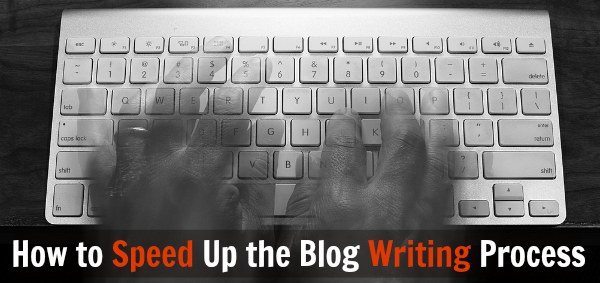

How to Speed Up the Blog Writing Process [My Method]
Earlier today I was asked for tips on how to speed up the writing process when writing longer posts.
I don’t know that I have an answer that will help everyone with that one as I think it partly comes down to personal style, experience level and skill – but two thoughts did come to mind based upon my own experience.
And before I share them – one quick note/disclaimer…. sometimes slow is best.
While I will talk about my process for writing that has helped me get a little quicker as a writer I do think that it is important not to rush your posts. Slow blogging can lead to posts which have more depth and that are more useful to your readers.
Having said that – I think there are times where bloggers spend so long on tweaking and perfecting their posts that perhaps they could do with some speeding up.
OK – enough disclaimers – here are my two tips!
1. It takes Practice
I remember in my early days when I’d spend hours writing even the shortest of posts. While there are still some posts that are more of a grind to write and can take time (for example three days ago I spent most of the day working on the Ultimate Guide to Writing Comments on Blogs) I do think that my writing has sped up when I compare it to how I used to write.
Related to this idea of practice is that when I write regularly I find that I write faster. If I write every day I get into a groove but if I take a couple of weeks off for a vacation I often find it really difficult to get going again.
While I don’t think every blog needs to publish a post every day – I do see this as a good argument for bloggers to write something every day – just to keep your writing flowing.
2. Break it Down: How I do It
The second thing that comes to mind is that when I approach a larger topic and sit down to write what I think will be a longer post I tend write in a different way to when I write shorter posts.
Knowing that the topic is big I will often try to come up with an outline for the post before I start.
Start with a List
For me this means I almost always create a bullet point list before I start writing a longer post.
The list simply contains the main points or sub topics that I want to touch on in the post. Each point might simply be a word or two but as I create the list I begin to look at the post not as a massive overwhelming job but as a series of smaller tasks that I need to work through to write the post.
Expand Each Point
With the list in hand I will generally try to start writing a paragraph or two on each point.
Of course as I write inspiration might come and I might add in points or change their order – but with the list to work through I quite often find that the post is written before I realise it.
Introductions, Conclusions and Titles
Once I’ve worked through all the points I will usually go back to to the beginning and work on my post title, write an introduction (or tweak what I’ve already written) and will then work on a conclusion and call to action.
I know some people like to write their introduction first but I find my introductions flow a lot better if I know what I’ve written rather than writing an introduction to something I’m not completely sure of how it will end.
Make it Flow and Consider Format
Sometimes I might also need to work a little on tying points together to make the post flow but as I tend to write articles in a single sitting I will often have naturally done this as I’ve written.
The other thing to consider at this point is how I’ll format the post. Because I’ve started with a list might mean that the post ends up looking like a list. A good example of this is my recent post ‘7 Ways to Stay Inspired and Avoid Bloggers Burn Out‘ in which I followed this exact process and then number each of the points in the post.
Your post need not be numbered or look like a list though. Alternatively you might just use headings to start each point without any numbers (as I did recently in my post on on my Facebook experiments) or you might even choose to present the post as an article/essay without any headings.
My personal preference is to break a post down with headings, steps or into a list – mainly because I think it makes my posts easier to read (see below on this).
Edit and Polish
Last of all comes a once over to Edit and Polish the post.
I personally find that this stage works best for me if I have a break from writing – even an hour or two away from the post gives a little perspective and can help make final edits that take the post up a notch.
Good for the Writer and Good for the Reader
The other thing worth mentioning is that this style of writing (starting with a list) can end up producing articles that are not only easier to write – but easier to read.
I find that my readers often give more positive affirmations on a post if its broken down into a well organised flow and smaller sections.
This doesn’t mean you can’t go deep into a topic – but just think about how you can get to that deeper destination by breaking it down and ordering your points to get them to the place you want to take them.
How Do You Tackle the Writing Process?
Do you write outlines for posts or are you someone who prefers just to sit and write?
I’d love to hear a little about how you tackle the task of writing in comments below.
Further Reading:
If you’d like to learn a little more about my writing process check out my series – How to Craft a Blog Post which explores 10 points to pause in the writing of a post to make it a better post.
Originally at: Blog Tips at ProBlogger
Facebook comments:
No Comments »
No comments yet.
RSS feed for comments on this post. TrackBack URL
Leave a comment
















